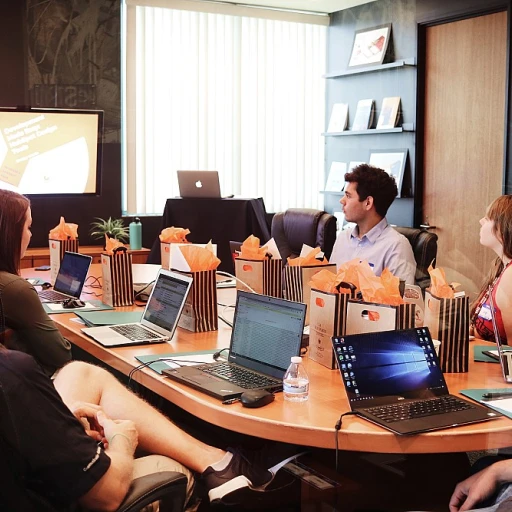
Understanding the Importance of Client-Centric Reskilling
Recognizing the Value of Client Focus in Reskilling
In today's rapidly evolving business landscape, organizations must align their reskilling efforts with client goals to ensure mutual success. Understanding the importance of client-centric reskilling involves creating a strategy centered on the needs and objectives of the customer. By focusing on this approach, businesses can build trust and foster long-term partnerships. An essential aspect of this strategy is engaging in open communication. Clients and service providers must engage in regular check-ins to ensure that their mutual goals are consistently aligned. This proactive communication allows both parties to adjust strategies as needed, addressing any challenges that may arise. It's crucial to emphasize the role of strategic partnerships in achieving client goals. These partnerships go beyond mere transactions, positioning both businesses as partners working towards shared goals. Establishing a clear understanding of roles, responsibilities, and expectations forms the foundation of a successful partnership. Furthermore, incorporating customer success strategies fosters growth. When organizations prioritize aligning their reskilling programs with client objectives, they pave the way for shared success and growth in the long term. Effective decision making, rooted in a shared vision, becomes a key driver for successful partnerships. Lastly, ensuring alignment in goals and maintaining strong communication enhance the chances of successful outcomes. By prioritizing the client's vision and demonstrating commitment to mutual action, organizations not only build trust but also secure their position as valuable partners in the journey of reskilling. For a deeper understanding and guidance on navigating this imperative career shift, refer to our comprehensive guide here.Identifying Client Needs and Objectives
Prioritizing Client Objectives and Understanding Their Impact
Embracing client goals is fundamental in a successful reskilling strategy. When clients seek reskilling solutions, their primary aim is often to bridge skill gaps that hinder growth and success. Identifying these objectives early on enables effective communication and fosters strong partnerships that align with the long-term vision of both parties. By engaging in goal alignment, businesses effectively translate client needs into actionable reskilling plans.To develop an effective strategy, it's crucial to delve deep into clients' business goals. This requires businesses to understand the specific challenges clients face and the roles and responsibilities involved in meeting those challenges. Clear comprehension of these aspects helps ensure that the reskilling initiative aligns with the client's organizational goals. Additionally, this approach ensures that both parties share a mutual commitment to achieve mutual success.
- Open Communication: Business partnerships thrive on open, ongoing dialogue. Regular check-ins are vital as they ensure continuous alignment with client goals and strategic adjustments when necessary.
- Defining Success: Clearly understanding what success looks like for the client is essential. Each partner should feel comfortable voicing their needs and adjustments should be made in a collaborative manner.
- Selecting Indicators: It’s important to establish criteria and measures of success to track the effectiveness of the reskilling initiative, thus enabling partners to adapt strategies as needed.
Establishing Trust and Fostering Long-term Partnerships
Achieving a shared vision requires a foundation of trust and integrity. This mutual action extends beyond mere contractual agreements to embody a deeper understanding and alignment with the client’s business aspirations. Effective communication between partners is crucial, as it ensures the decision-making process is informed, transparent, and aligned with shared goals.Partnerships built on trust provide a conducive environment for continuous collaboration, enabling adaptive strategies that effectively tackle evolving challenges. With a unified team committed to the same objectives, achieving mutual goals becomes not only attainable but sustainable in the long run.
If you're exploring alternatives to enhance client-focused reskilling programs, understanding these strategies can guide successful partnerships. Dive deeper into exploring alternatives to Year Up and uncover more insights into effective reskilling programs.
Building Collaborative Partnerships
Fostering Strategic Partnerships
Building collaborative partnerships is a cornerstone for achieving mutual success in reskilling. These partnerships transcend mere business interactions to become strategic alliances that drive long-term growth. For a successful partnership, aligning goals with your partners is essential. This requires an effective communication strategy that involves open communication channels, regular check-ins, and shared decision-making processes.
When establishing these partnerships, it is vital to understand the roles and responsibilities of each party. A shared vision and mutual goals lay the groundwork for collaboration, fostering trust and alignment with client goals. The key is to engage customers and maintain a shared understanding of objectives, even when challenges arise. This ensures that all parties are working toward the same end target.
Moreover, strategic partnerships enable businesses to tap into each other's strengths, facilitating mutual success through collective action. Sales teams can play a pivotal role by understanding how reskilling programs align with business partnerships. Establishing a culture of trust and open communication is imperative for managing expectations and measuring success, as discussed in previous sections.
Regular check-ins and strategic communication are not just about addressing issues; they also celebrate milestones and mutual achievements, bolstering the relationship. As partners work together towards shared goals, this structured collaboration promotes the client's growth and, consequently, the success of the reskilling initiative. For an in-depth exploration into aligning partner roles with client objectives, visit understanding skill levels in reskilling.
Designing Flexible Reskilling Programs
Creating Tailor-Made Solutions for Effective Reskilling
Designing reskilling programs that resonate with clients' specific goals is a cornerstone for mutual success. This requires a deep understanding of the client's unique objectives, challenges, and aspirations in order to craft a program that not only meets their needs but also fosters long-term partnerships built on trust and transparency. In tailoring reskilling solutions, the focus should be on fostering strategic partnerships between providers and clients, where both parties have a shared vision and commitment towards mutual growth. Regular communication is key to ensuring that these customized programs are aligned with client goals and adapting to any evolving demands. Open channels of dialogue enhance decision making and facilitate effective collaboration, as they allow for regular check-ins where roles and responsibilities can be clearly defined. Adopting a flexible approach is crucial in addressing the varying needs of different businesses. A one-size-fits-all methodology may not suffice in a landscape where each client is navigating their own set of challenges. Programs must be adaptable to accommodate changes in business objectives, ensuring alignment with client goals and ultimately fostering customer success. Moreover, the implementation of these tailor-made programs should consider the sales team, encouraging them to take an active role in understanding how reskilling initiatives support both the client's operational needs and the provider's strategic goals. This collaborative approach not only enhances the success rate of the reskilling efforts but also fosters a culture of mutual respect and shared responsibility. In conclusion, by prioritizing effective communication and a shared commitment to achieving client success, reskilling programs can be designed to create impactful, long-term partnerships that drive mutual goals and business growth.Measuring Success and Adjusting Strategies
Tracking Progress through Effective Evaluation
Measuring success in client-centric reskilling programs involves a comprehensive approach that combines regular evaluation and strategic adjustments. Establishing mutual goals and shared objectives with clients allows for clearer assessment metrics. This collaborative effort helps both parties, fostering a partnership grounded in shared vision.- Setting Clear Objectives: From the outset, defining mutual objectives between clients and partners enables transparent evaluation. This alignment ensures both teams work towards common milestones and shared outcomes.
- Constructing Evaluation Metrics: Developing robust metrics that reflect these shared goals is essential. By incorporating key performance indicators relevant to the client's business, organizations can better track progress and pivot strategies as needed.
- Regular Assessment and Feedback: Effective communication is vital for successful partnerships. Regular check-ins and open communication channels help address challenges and reinforce the alignment of goals. These interactions foster trust and support collaborative decision making.
- Adapting and Evolving Strategies: No reskilling program is static; flexibility in program design allows for adjustments based on regular assessments. Being open to feedback and ready to modify the approach ensures the program's relevance and effectiveness over time.













